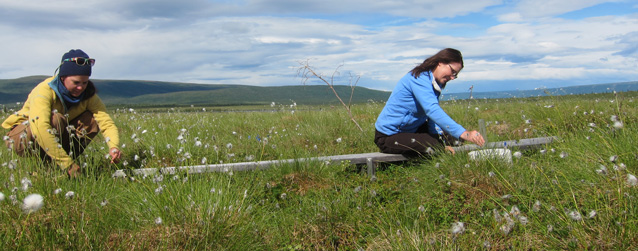
Photo courtesy of Tamara Harms and Michelle McCrackin
Climate warming is causing permafrost to thaw. In and near Denali National Park and Preserve, the temperature of permafrost (ground that is frozen for two or more consecutive years) is just below freezing, so a small amount of warming can have a large impact.
Where tundra ecosystems have intact permafrost, vast quantities of N and other nutrients, including carbon, are sequestered (stored) in the frozen organic matter beneath the surface. But the nutrients in frozen soils are largely unavailable to plants and soil microorganisms. In these tundra systems, the N cycle is considered “closed” because there is very little “leakage” of N from soils, either dissolved in liquid runoff or as emissions of N-containing gases.
Has a warming climate influenced N cycling in the tundra at Denali similarly to what has been documented in arctic regions? That is, where permafrost has thawed, is there a change from a closed to an “open” N cycle? And, if the N cycle is more open near Denali, which forms of N are being leaked from the tundra ecosystem?
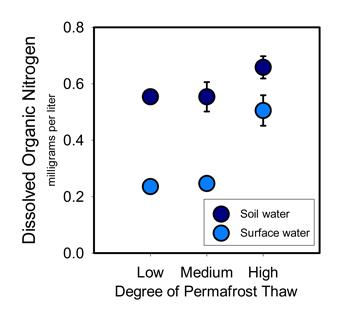
Climate Change and Nitrogen in Tundra
Where permafrost has thawed or has been physically disturbed (i.e., churning from freeze-thaw cycles) in arctic tundra, researchers have documented losses of N from the ecosystem (in runoff or as gases). These losses result in a more open N cycle.
Thawing permafrost increases the depth of the active layer (the shallow layer that freezes and thaws seasonally) and unlocks the N and other elements from previously frozen organic matter. Thawing permafrost potentially increases the amount of N available to organisms. Researchers working in arctic tundra have found that permafrost thaw enhances soil microbial activity that releases dissolved or gaseous forms of N.
When previously frozen organic N is added to the actively cycling N pool, plant growth may increase, but the amount of N may be more than can be used or retained by the plants or microorganisms in the ecosystem. Excess N can leak out of soils into streams and lakes, where it can cause blooms of algae. In addition, more N may be lost to the atmosphere as nitrous oxide, a greenhouse gas that influences global warming 300 times more than carbon dioxide, and contributes to ozone depletion in the atmosphere.
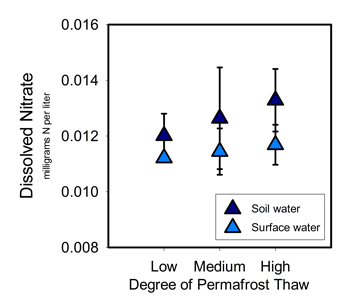
Studying Changes in Tundra Nitrogen Cycling
To explore questions about permafrost thaw and leakage of N near Denali, in 2011, Dr. Tamara Harms (University of Alaska - Fairbanks) and Dr. Michelle McCrackin (Washington State University - Vancouver) studied thawing permafrost along the Stampede Road corridor, just northeast of the park.
If warming is affecting N cycling, the researchers expected to find that the concentrations of dissolved N are greater in soil and surface water where there is more extensive permafrost thaw. Likewise, gaseous nitrous oxide flux from the soil surface would be greater in soils where permafrost has thawed substantially.
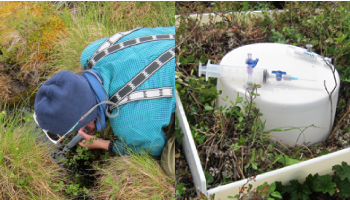
NPS Photo
Detecting Changes in N Cycling
Harms and McCrackin selected sites that differed in degree of permafrost thaw: low (nearly intact permafrost), medium (~30 years of thaw) and high (~100 years of thaw).
At each site, Harms and McCrackin measured the abundance of three forms of N: dissolved organic N, dissolved nitrate (NO3 -), and nitrous oxide (N2O, a gas produced by microorganisms in the soil).
To measure the concentration of dissolved N that could leave the ecosystem via runoff—as organic N and nitrate—the researchers collected water from saturated soils at different depths using long needles. They also collected standing water found in surface depressions using syringes (see left photo).
To measure the N2O flux (rate of gas emission from the soil), the researchers first capped the soil surface with small chambers (see right photo)—where gases produced by the soil accumulated—and then extracted samples of this chambered air.
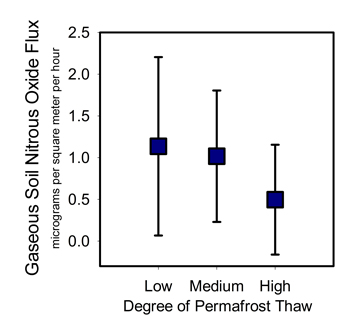
Study Results
Dissolved N in soil and surface water. The concentration of dissolved organic N was highest—in both soil water and surface water—at the site where permafrost thaw was high (see graph with circles above; dark blue represents samples from soil water and light blue samples from surface water). The concentration of dissolved nitrate in soil water and surface water did not differ among sites (see graph with triangles above).
Flux of N-containing gases from the soil surface. The flux of N2O gas from the soil surface was zero or very low across all of the sites and there was no statistically signficant difference among sites that differed in degree of thaw (see graph with squares - right).
Interpreting the Results for Park Management
The results suggest that thawing permafrost near Denali does contribute to a slightly more open N cycle, in that concentrations of dissolved organic N were greatest in soil and surface water at sites with a high degree of permafrost thaw. However, compared to nitrate, organic N is not as easily used by organisms, so there could be limited effects of elevated organic N concentrations on tundra ecosystems at this time.
In other high latitude ecosystems, a more open N cycle is associated with thermokarst (collapse of tundra from thawing). Elevated concentrations of dissolved organic N and nitrate have been documented in rivers that drain areas with thermokarst, and large fluxes of N2O gas were observed at sites where physical disturbance to the permafrost had exposed bare soil.
Such conditions of thermokarst accompanied by bare soil were not observed along Stampede Road, but may exist in the Toklat Basin (within the park) or may develop in the future along the Stampede Road or in tundra ecosystems elsewhere in the park—if permafrost thaw continues or accelerates. If such thermokarst develops, the N cycle in these subarctic tundra ecosystems may become substantially more open (i.e., leak higher concentrations of dissolved organic nitogen and nitrate, and result in substantial N2O fluxes).
Understanding how the N cycle in tundra systems responds when permafrost thaws allows park managers to be alert to potential changes in nutrient availability in areas of permafrost thaw. When more N is available in tundra ecosystems, plant growth may increase, and there may be changes in terrestrial or aquatic communities under the new conditions. Monitoring permafrost will keep the park informed of thaw and response in tundra ecosystems.
Last updated: April 21, 2016
